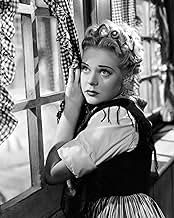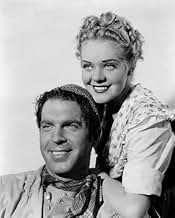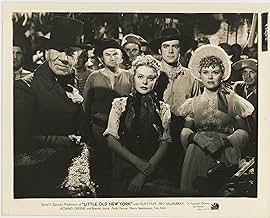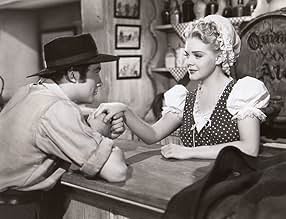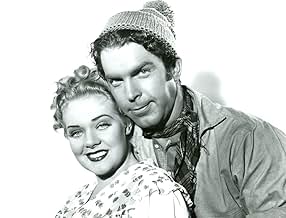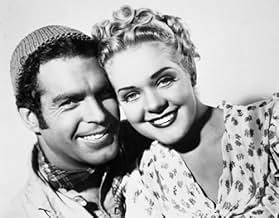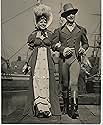IMDb RATING
6.4/10
276
YOUR RATING
Steamboat inventor Robert Fulton shows up in New York in 1807. Tavern keeper Pat O'Day believes in him, but her boyfriend doesn't. All seems lost after sailors, afraid of losing their jobs, ... Read allSteamboat inventor Robert Fulton shows up in New York in 1807. Tavern keeper Pat O'Day believes in him, but her boyfriend doesn't. All seems lost after sailors, afraid of losing their jobs, burn his boat.Steamboat inventor Robert Fulton shows up in New York in 1807. Tavern keeper Pat O'Day believes in him, but her boyfriend doesn't. All seems lost after sailors, afraid of losing their jobs, burn his boat.
- Director
- Writers
- Stars
Clarence Wilson
- Willie Stout
- (as Clarence Hummel Wilson)
Theodore von Eltz
- Washington Irving
- (as Theodore Von Eltz)
Oscar 'Dutch' Hendrian
- Blackie
- (as O.G. Hendrian)
- Director
- Writers
- All cast & crew
- Production, box office & more at IMDbPro
Featured reviews
In this historical drama, Richard Greene stars as the designer of the steamboat. At first, no one's interested enough to finance his project, but with the help of his new friends, the low class but tenacious Fred MacMurray and Alice Faye, he shows his model to more and more people. Added into the mix are brawny bully Ward Bond, silly sailor Andy Devine, and Ben Carter, Alice's hired hand whom she treats terribly and always accuses of stealing drinks.
A warning for all Alice Faye fans: it's just as obvious that she's out of Richard's league as it is that she's falling in love with him, and it's a bit sad. Richard falls for Brenda Joyce and her wealthy uncle Henry Stephenson, who's financing his steamboat. Alice looks very cute in this movie, and it's not fun to see her getting her heart broken over a fellow who isn't worth it-which, let's face it, is the only type of fellow who goes around breaking hearts. Also, this isn't a musical, and the only song, "Who Is the Beau of the Belle of New York," is sung and danced to during an outdoor celebration. It's a very cute song, but so brief that this movie qualifies as one of Alice's only non-singing roles.
A warning for all Alice Faye fans: it's just as obvious that she's out of Richard's league as it is that she's falling in love with him, and it's a bit sad. Richard falls for Brenda Joyce and her wealthy uncle Henry Stephenson, who's financing his steamboat. Alice looks very cute in this movie, and it's not fun to see her getting her heart broken over a fellow who isn't worth it-which, let's face it, is the only type of fellow who goes around breaking hearts. Also, this isn't a musical, and the only song, "Who Is the Beau of the Belle of New York," is sung and danced to during an outdoor celebration. It's a very cute song, but so brief that this movie qualifies as one of Alice's only non-singing roles.
This film sports winning performances (Alice Faye is delightful and very accomplished as a light comic actress), plenty of well-played comedy and well-staged action, a fine Alfred Newman score. But what really impressed and intrigued me were some elaborately staged outdoor scenes which appeared to be at least partially shot on a real 18th century seaport, not just the back lot. Either Fox spent a whole lot of money constructing a very large and realistic looking seaport set, or some of this was shot on location at some historic recreation site, or the art director was a genius in making the back lot look a lot bigger than it was. Interesting to see what a muscular hunk Fred MacMurray was, very different than his image in later years.
Nothing deep, but an interesting Hollywood-ized account of the development of steam propeled ships. Imagine... being able to propel a vessel upstream even into the wind! But at what risk? The current economy's support? And how do you pay for the thing?!?! Additionally, you have a young country out to protect its interests... but what if it acted Isolationistically? Would you be able to pursue your dreams? If the overdeveloped subplots of "Sink the Bismark" did'nt offend your sensibilities greatly, you will enjoy this yarn.
Robert Fulton after trying and failing to develop a ship powered by a steam engine is having trouble getting some new backing. A prototype vessel blew up on the River Seine as he was trying to impress Napoleon Bonaparte with steam's potential. Now he's back in Little Old New York trying to sell the idea to the movers and shakers of his day.
Richard Greene plays the idealistic and gentlemanly Fulton. But the only two converts he makes are his landlady, tavern owner Alice Faye and Fred MacMurray, who works for Ward Bond at a shipyard. But after Fulton beats bully boy Bond in a fight, MacMurray loses his job. But Fred starts his own shipyard and his first client will be Fulton if he can raise the money.
Little Old New York had the story of Robert Fulton grafted on to a play by Rida Johnson Young of the same name that was the basis for the film. There's no mention that in real life Fulton was as handy with his dukes as he is in this film. It is true he married the niece of Chancellor Robert Livingston played by Brenda Joyce and Livingston did finally sell some of his friends like Nicholas Roosevelt, John Jacob Astor, and Washington Irving to finally back Fulton's steamboat.
Livingston is played by one of my favorite character actors Henry Stephenson who always brings a touch of old world class to all his roles. Livingston's title of Chancellor stems from the fact the chief judicial officer of New York had that title, a carryover from colonial days. Among other things Livingston did was swear in George Washington to his first term as president. There was no Supreme Court yet because Washington hadn't appointed anyone yet.
Little Old New York probably was seen by Darryl Zanuck as a fitting sequel to In Old Chicago which was Alice Faye's first period costume film. The parts that Fred MacMurray and Richard Greene have are those that would normally have been played by Tyrone Power and Don Ameche. In fact I could see both of those guys playing either of the MacMurray or Greene parts.
If Little Old New York is not the real story of Robert Fulton it certainly is a nice bit of entertainment served up by a fine cast at the direction of Henry King.
Richard Greene plays the idealistic and gentlemanly Fulton. But the only two converts he makes are his landlady, tavern owner Alice Faye and Fred MacMurray, who works for Ward Bond at a shipyard. But after Fulton beats bully boy Bond in a fight, MacMurray loses his job. But Fred starts his own shipyard and his first client will be Fulton if he can raise the money.
Little Old New York had the story of Robert Fulton grafted on to a play by Rida Johnson Young of the same name that was the basis for the film. There's no mention that in real life Fulton was as handy with his dukes as he is in this film. It is true he married the niece of Chancellor Robert Livingston played by Brenda Joyce and Livingston did finally sell some of his friends like Nicholas Roosevelt, John Jacob Astor, and Washington Irving to finally back Fulton's steamboat.
Livingston is played by one of my favorite character actors Henry Stephenson who always brings a touch of old world class to all his roles. Livingston's title of Chancellor stems from the fact the chief judicial officer of New York had that title, a carryover from colonial days. Among other things Livingston did was swear in George Washington to his first term as president. There was no Supreme Court yet because Washington hadn't appointed anyone yet.
Little Old New York probably was seen by Darryl Zanuck as a fitting sequel to In Old Chicago which was Alice Faye's first period costume film. The parts that Fred MacMurray and Richard Greene have are those that would normally have been played by Tyrone Power and Don Ameche. In fact I could see both of those guys playing either of the MacMurray or Greene parts.
If Little Old New York is not the real story of Robert Fulton it certainly is a nice bit of entertainment served up by a fine cast at the direction of Henry King.
Though it probably has zip to do with the actual story of Robert Fulton and the invention and manufacture of the first steam engine this is a very pleasant little drama with light overtones. That's mainly due to the cast, all very competent performers who have a nice chemistry together.
Alice Faye, not singing this time, is full of brassy snap as the most virtuous waterfront innkeeper who never existed who longs to leave the docks behind and become a lady. She's matched by Fred MacMurray full of cheery bonhomie as a shipbuilder, the now amusingly named Charley Brownne, who has a yen for Alice. Richard Greene is a bit of a stick as Fulton but he and Brenda Joyce make an attractive pair. And Andy Devine is along to add his squeaky voiced charm as a buddy of the lead pair.
The title, an obvious attempt by Fox to conjure up thoughts of Alice's big hit of a few years before, In Old Chicago, has very little to do with the picture. You hardly see any outdoor shots of the city but the interior sets are handsomely mounted if unimaginatively lit as you'd expect for a Fox feature for their top star.
If you're looking for a history lesson about the progress of navigation during the country's early years you won't find it here but if a enjoyable diversion for about an hour and a half is what you seek this will fill the bill. Nothing spectacular but a nice hidden gem for fans of the stars.
Alice Faye, not singing this time, is full of brassy snap as the most virtuous waterfront innkeeper who never existed who longs to leave the docks behind and become a lady. She's matched by Fred MacMurray full of cheery bonhomie as a shipbuilder, the now amusingly named Charley Brownne, who has a yen for Alice. Richard Greene is a bit of a stick as Fulton but he and Brenda Joyce make an attractive pair. And Andy Devine is along to add his squeaky voiced charm as a buddy of the lead pair.
The title, an obvious attempt by Fox to conjure up thoughts of Alice's big hit of a few years before, In Old Chicago, has very little to do with the picture. You hardly see any outdoor shots of the city but the interior sets are handsomely mounted if unimaginatively lit as you'd expect for a Fox feature for their top star.
If you're looking for a history lesson about the progress of navigation during the country's early years you won't find it here but if a enjoyable diversion for about an hour and a half is what you seek this will fill the bill. Nothing spectacular but a nice hidden gem for fans of the stars.
Did you know
- TriviaThe play opened on Broadway in New York City, New York, USA on 8 September 1920 and closed in June 1921 after 303 performances. The opening night cast included Genevieve Tobin as Pat O'Day, Douglas Wood, as Cornelius Vanderbuilt and Donald Meek.
- GoofsThe hairstyles of the women are from the time the film was made, not from the early 1800s.
- ConnectionsReferenced in Star Dust (1940)
- SoundtracksWho Is the Beau of the Belle Of New York
(1940) (uncredited)
Music and Lyrics by Mack Gordon
Performed by Tyler Brooke and joined by Alice Faye and other dancing patrons of Krausmeyer's Pavillion
Details
- Release date
- Country of origin
- Language
- Also known as
- Little Old New York
- Filming locations
- Production company
- See more company credits at IMDbPro
- Runtime1 hour 40 minutes
- Color
- Aspect ratio
- 1.37 : 1
Contribute to this page
Suggest an edit or add missing content

Top Gap
By what name was Les révoltés du Clermont (1940) officially released in India in English?
Answer
